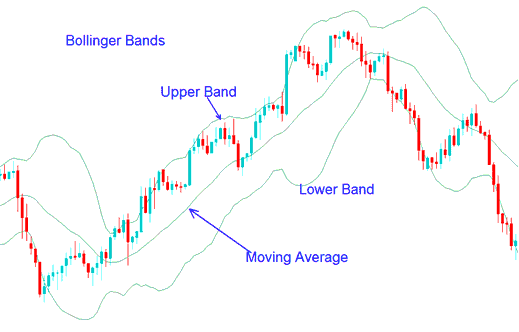Bollinger Bands Strategy
- How Bollinger Bands Works
- Bollinger Bands Volatility Analysis
- Bollinger Band Bulge and Squeeze
- Bollinger Band Price Action in Trends
- Bollinger Band Price Action in Range-Bound Market
- Bollinger Band and Trend Reversals
- Bollinger Band Strategy Summary
Bollinger Band Strategy
The Bollinger Band indicator helps to see how much the price changes. The Bollinger Bands indicator is used on the price chart itself.
The Bollinger Band indicator comprises three bands: the mid-band (a moving average), an upper band, and a lower band. Prices typically fluctuate within these bands.
The Bollinger Bands indicator creates upper and lower bands around a moving average (MA). The default setting is a 20-SMA, and these bands are calculated using standard deviations from the moving average.
The example of Bollinger Band indicator is illustrated and shown below.

Bollinger Bands Indicator - How to Trade with Bollinger Bands Strategy
Because standard deviation is a measure of price volatility & volatility of the market is dynamic, the trading bollinger bands keep adjusting their width. Higher price volatility means higher standard deviation & the more the bands widen. Low price volatility means the standard deviation is lower and the bollinger bands contract.
The Bollinger Band fx indicator uses price changes to show a lot about how the price moves. The price information from the bollinger bands indicator includes:
- Periods of low price volatility - consolidation phase of the trading market.
- Periods of high price volatility - extended trends, trending markets.
- Support and resistance levels of the price.
- Buy and Sell points of price.
Study More Tutorials & Courses:
- How to Trade Bullish Gold Pattern Break Out
- What's the Minimum Trade Volume for a Mini XAUUSD Account?
- Explanation of How to Hide Symbols on the MetaTrader 4 Trade Platform
- Gold Chart Timeframe: Periodicity in Charts in Software
- How Do You Use Gold Platform MT5 Platform?
- Gold Tutorial Guides List of XAUUSD Indicators
- Previous Day Close Break-out XAU USD Strategy and Market Open Strategies
- How to Add Parabolic SAR XAUUSD Indicator in Chart in MetaTrader 4 Platform

